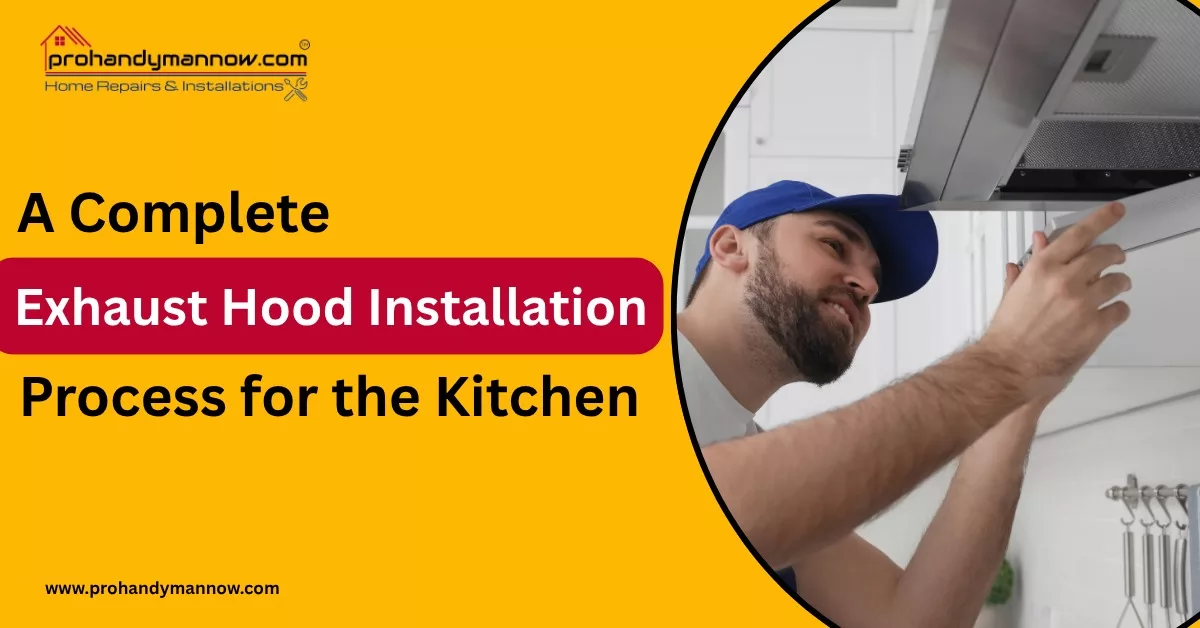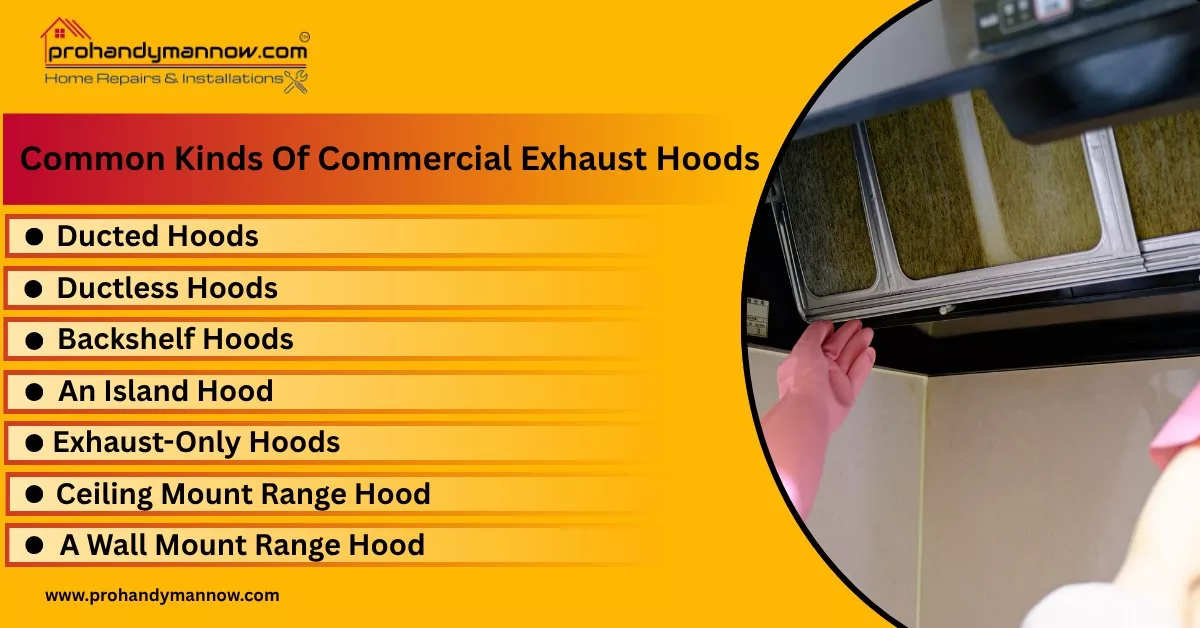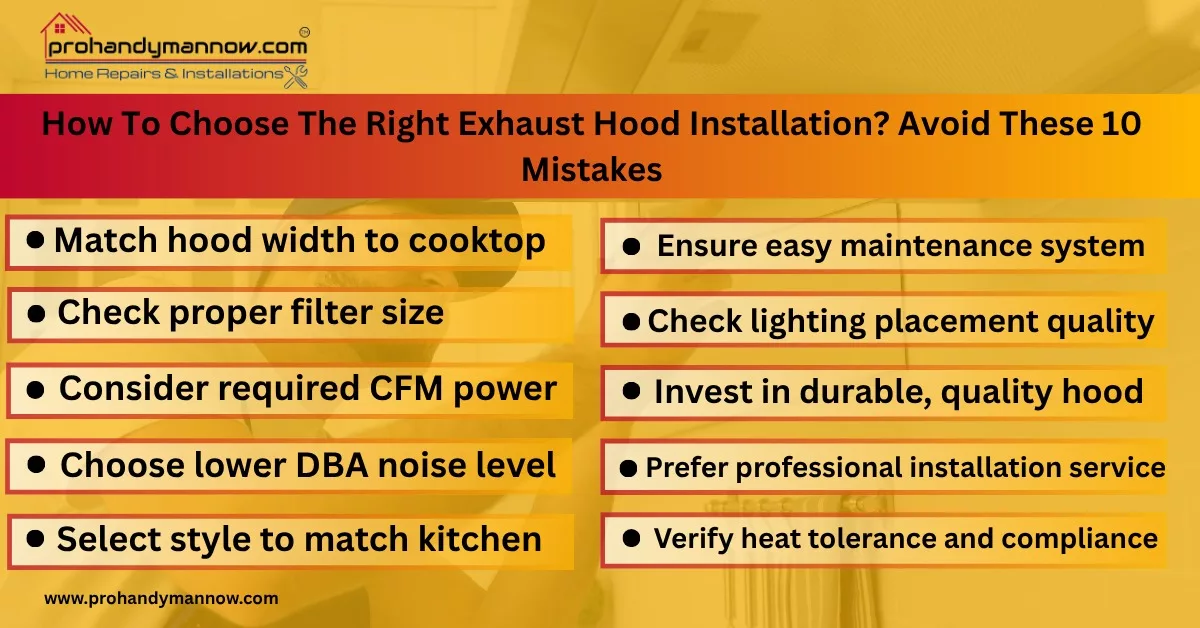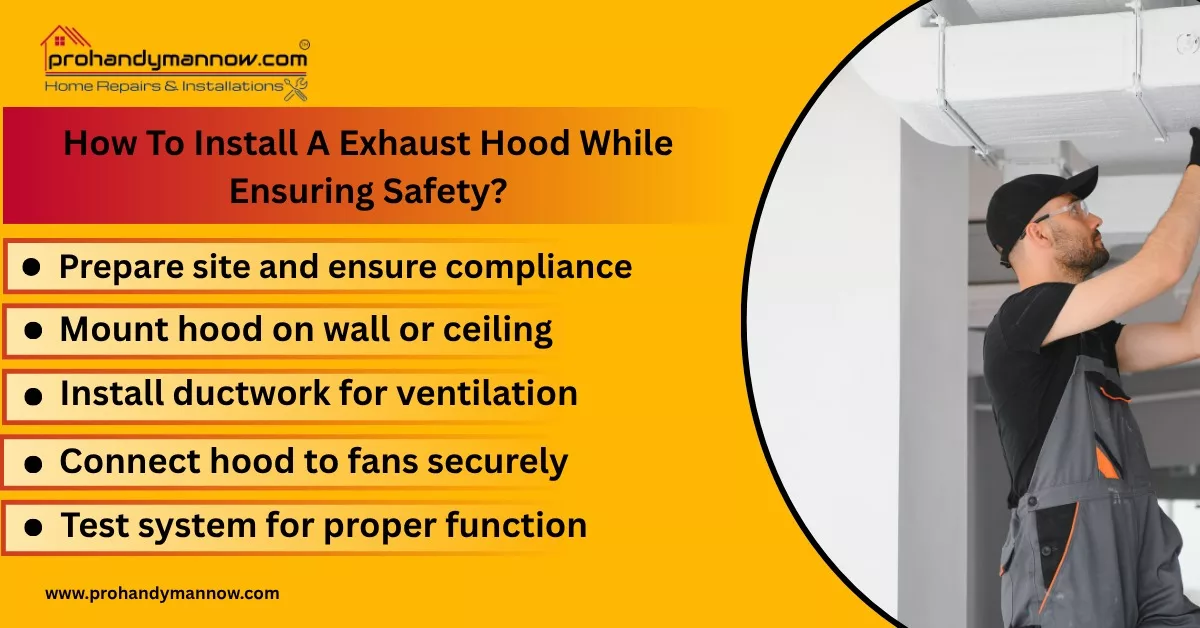
Whether you run a food-related business or want to update your kitchen system with an improved exhaust hood installation. Ensuring proper safety precautions is suggested. It’s possible when you’re aware of the available options and their pros and cons. You need to remain updated on your options and avoid mistakes. This can lead to casualties in the functionality of the hood systems. You can cook better and prevent accidents with the right type of exhaust hood system.
—————————————————————————————————————————————————————————————————
Exhaust Hood Installation Process: Key Steps for a Safer Kitchen
Exhaust Fan | Make up air system | Fire suppression system
A proper kitchen system for commercial industries, especially restaurants, is a must. It’s possible with the right exhaust hood installation techniques. Otherwise, you have to face fire accidents because of the poorly installed exhaust systems. The continuous grease in the grills and fryers can affect the already poorly installed systems. They can catch a spark, leading to adverse incidents. However, commercial exhaust hood installation proves a suitable and safe preventive strategy in such situations.
But fire is just a part of many casualties. Proper ventilation in kitchens is a must to avoid suffocation and unsafe working environments. A professional restaurant exhaust hood installation can help avoid such issues. People can work safely and don’t have to be continuously answerable to the inspectors. It’s not an optional procedure; it’s a must-have requirement for all-sized businesses.
What Does Kitchen Hood Installation Mean?

A commercial exhaust hood is required for the primary ventilation system in food-related businesses. The main function of exhaust hood installation is to manage:
- Heat extraction.
- Smoke.
- Steam.
- Airborne grease.
- Reduce odours.
- Cross-contamination prevention.
- Better air quality.
- Improved work conditions.
If this system is not installed properly, it can lead to adverse conditions. You have to continuously manage the dangerous grease and fume buildups. These situations can increase the risks of fire incidents and violations of regulatory codes. When you have the proper kitchen exhaust hood installation system, you can avoid such situations and ensure:
- Better regulatory compliance.
- Increased kitchen equipment durability.
- Improved health and working conditions for the staff.
Common Kinds Of Commercial Exhaust Hood Installation

Before you choose any exhaust hood installation procedure, you need to learn about the types available in this procedure. Commercial food businesses can choose a suitable type according to their kitchen needs, budget, cooking styles, layouts, and quality requirements.
Type 1 Hoods
These are heavy-duty hoods, which most restaurants prefer. They are built to manage grease, smoke, heat, and anything that can produce grease-based chemicals. It’s a suitable option for your needs if your kitchen always faces high heat and greasy cooking situations.
Type 2 Hoods
These are lightweight hoods designed for use in steam, heat, and high-moisture environments. However, they’re not the ideal type for grease and smoke. They are usually installed in areas where grease is not an issue, like above dishwashers, boiling stations, and ovens.
Combining Type 1/2 Hoods
Various exhaust hoods combine types 1 and 2 for better versatility and usage purposes. When your cooking setup changes or you want to try new options, flexibility can allow improved cooking experiences.
A Wall Mount Range Hood
Wall-mounted hoods are available so you can attach them behind the wall and your cooking equipment. Like a range, grill, or fryer. It proves a solid option for kitchens with limited spaces, as it remains lined up along the wall.
Ceiling Mount Range Hood
It’s a modern, low-profile ventilation unit installed either flush or suspended from the kitchen ceiling. It is designed to capture grease and odours discreetly without complete obstruction.
An Island Hood
When your cooking equipment is located on an island, choosing an island hood is the reliable option. They hang from the ceiling and cover all the cooktop edges and the range. People prefer this option with open kitchens and black kitchen setups for the perfect environment. They offer complete coverage while ensuring the safety and cleanliness of the environment.
Ducted Hoods
This option is different from other options. You don’t require ductwork or an exterior vent hood for this exhaust hood installation. They are not only suitable for venting air outside but also offer filtration for letting out:
- Grease.
- Bacteria.
- Odours.
Ducted Hoods are also beneficial for recycling the filtered air back into your kitchen. They offer placement flexibility with their lightness. They are ideal options for places where ductwork installation is not possible.
Ductless Hoods
Ductless hoods don’t vent air outside. Instead, they range hood filter to remove grease, bacteria, and odours to recirculate the cleaned air back into the kitchen.
It uses filters without requiring external ductwork or an exterior dryer vent. They are suitable for kitchens and apartments with simple installation requirements. However, they require periodic filter replacement.
Backshelf Hoods
They are installed directly behind cooking equipment and contain backsplash for better protection against grease and other issues. It provides an ideal solution for limited space kitchens. They provide complete ventilation while maintaining their aesthetic appeal.
Exhaust-Only Hoods
This type of exhaust hood installation helps in expelling air outside without requiring special systems. Hoods are suitable for specific kitchen configurations with better solutions and range hood vent size availability. They are suitable for areas where makeup air systems are not needed.
Exhaust Hood Installation: Top Ducted VS Ductless Range Hood Differences
When you’re considering different range hood sizes, you need to learn the differences between duct and ductless hoods. It helps commercial businesses and homeowners make better decisions.
- A range hood duct size offers external ventilation, while a ductless system provides recirculating ventilation.
- You need to connect a range hood to a duct in the ceiling, wall, or floor as a must-have requirement. On the other hand, a ductless range hood can be placed nearly anywhere.
- It is limited to the place where you install it. In contrast, a ductless system filters air instead of completely removing it.
- A duct range hood system helps decrease smoke, grease, and odours in the home. Also, a ductless hood requires filter cleaning regularly.
- Installing a duct range hood is suggested if you want to use the oven range daily. Have enough space, a proper budget, and you’re a professional chef. On the other hand, a ductless system is suitable for a limited budget and compact spaces. When you don’t want regular maintenance or installation of ductwork, choosing this option is suitable.
How To Choose The Right Exhaust Hood Installation? Avoid These 10 Mistakes!

When selecting the right range hood exhaust installation, consider multiple key features.
-
-
- Choosing the right range hood filter sizes is the most important feature. You must ensure the width of the range hood is the same as the cooking surface it’s covering. Proper coverage and ventilation are possible when venting. Standard range and cooktop sizes are 30-36 inches wide.
- DBAs help in measuring the noise level of a range hood. The lower the number you choose, the quieter it gets. When you’re considering the product specs, check out the listed DBAs. Because they represent the sound created at the different vent settings of the speed.
- Range hoods are available in multiple types to meet the requirements of different people. Whether you prefer classic and simple styles or want modern and stylish options, choose carefully. Consider your kitchen style and how well it can fit your interior decor.
- Avoiding quality options can affect the overall durability, effectiveness, and mechanical issues. You need to choose high-quality range hood systems with better longevity and manufacturing.
- Range hoods usually demand professional installation for proper placement and better functionality. You shouldn’t start going DIY before properly understanding the installation requirements of different range hoods.
- When you’re selecting a range hood, consider its heat tolerance compatibility. Electric cooktops are usually suitable for all types of hoods. You need to consider the product specifications or the owner’s manual. It helps choose better options.
- Considering your kitchen style, cooking equipment, cooking needs, poor ductwork design, make-up air requirements, and fire suppression requirements. Filter maintenance and specific areas’ regulatory compliance are some additional factors.
-
How To Install an Exhaust Hood While Ensuring Safety?

Exhaust hood installation procedure is simple, but careful steps and their implementation are needed. Following the right steps can help get better outcomes.
Exhaust Hood Installation: Preparation And Planning
Preparing the installation site by removing all additional obstacles and cleaning the floor. Ensuring all utility connections and safe transportation of the range hoods help prevent injuries. You need to understand the specific hood installation and system requirements.
Also, learn about the regulatory compliance with local building codes. Choose a specific position for the hood according to your kitchen layout, cooking equipment, and available space. Having proper tools and equipment for the installation purpose is suggested. You must ensure there’s enough space for the installation of the:
-
-
- Hood.
- Ductwork.
- Ventilation fans.
-
Exhaust Hood Installation: The Hood Mounting
You need to choose whether the hood will be mounted on the wall or the ceiling. It depends on your specific kitchen layout and structural preferences. You can use a tape measure and a level to ensure the proper placement of the hood. You can attach the hood to the wall or the ceiling using the right mounting hardware and proper brackets. Proper levelling and connection with the structure is a must requirement.
Exhaust Hood Installation: Ductwork Installation
You need to arrange the duct setup for better airflow and ventilation in the kitchen. For proper measurement, cutting, and lengths of the duct pieces, using a duct cutter or a hacksaw is suggested. You can use suitable links or clamps to connect duct sections.
To avoid airflow leakage, you can seal all seams with high-temperature silicone weatherproof sealant or metal foil tape. Installing suitable elbows, transitions, and other fittings to route the duct and around the corners is beneficial. Ensure the ducting is sloping slightly downwards towards the ventilation fan for better grease and condensation drainage.
Hood Connection With The Duct And Ventilation Fans
Place the hood duct collar over the ductwork entry point. Using screws and clamps to secure the duct collar to the ductwork ensures a tight seal. Connecting the electrical cable to the hood’s control panel according to the manufacturer’s instructions is suggested.
Also, install the required grease traps and filters in the ductwork to capture grease and debris. Before placing them in the HVAC test and balance systems. Ductwork connection with the ventilation fans also helps in better sealing and secure results.
Exhaust Hood Installation: Functional Testing
Properly check out all the systems by practically using them and wait for any strange noises or vibrations. Or even smells to indicate the problems accordingly. Conducting a smoke test and making adjustments to complete your final inspection and proper installation. The overall exhaust hood installation procedure is suggested.
What Is The Current Commercial Exhaust Hood Installation Cost?

The usual cost of the exhaust hood installation is between $1,000 – $10,000+ per linear foot. It involves the basic hood setups and the complete turnkey systems. However, the complete price of this procedure is affected by various factors, including:
-
-
- Hood size.
- Type.
- Materials.
- Ductwork complications level.
- Fire suppression systems requirements.
- Local labour.
- Local regulatory codes compliance.
-
Expert Exhaust Hood Installation Near Me – ProHandymanNow!

Ensuring the safe exhaust hood installation for long-term relaxation is a must. It’s possible with the right professional assistance, like from Pro Handy Man Now.
-
-
- We have expertise in installing and replacing range hoods, vents, and microwave oven hoods.
- We can help with overall appliance repair for commercial businesses and homeowners for better range hood installation.
- We are the most reliable Handyman services offering company throughout the USA.
- We test all the range hood equipment for proper functionality and also offer additional alterations.
- You can learn more about us to ensure better services.
- Simply contact us on WhatsApp for further details.
-
Conclusion
To conclude, the Exhaust hood installation is a delicate procedure. Whether you choose professional or DIY installation, ensuring proper safety is a must. Whatever type of kind you choose in the range hood options, you must ensure it’s compatible with your specific requirements. Then, ignoring the specific mistakes most users make while installing this system can help gain better durability and functionality.
FAQs
What are the requirements for a commercial exhaust hood?
A commercial exhaust hood must extend at least 6 inches beyond all sides of the equipment. It should also provide proper cubic feet per minute (CFM) airflow.
How to use an exhaust hood?
You need to start the exhaust hood on a low setting before you start cooking. It will help in creating enough air path for fumes.
How to test an exhaust hood?
For testing the exhaust hood, you should turn it on and perform a paper test. Just hold a sheet of paper near the vent to see if the suction is holding it. Generate smoke or steam for more intense exhaust hood tests for a smooth airflow.
continue reading
Related Posts
Bathroom faucets are necessary elements in every home for temperature
Transform your home’s protection and appearance with the power of
A window screen is a protective shield for homeowners against




